Abstract
Tension strands are introduced to represent active myocardial fibers. They create one body force proportional to the divergence of the tension-direction vector, and a second equal to the tension divided by the radius of curvature. Explicit solutions to isotropic linearly elastic tensor equations with these body forces are found for the radially-symmetric, linearly-isotropic, elastic spherical heart with arbitrary radial body force. They confirm experiments showing supraluminal intramural pressures. Such pressures may affect coronary perfusion. A tension strand model which is a reasonable compromise between actual myofibrillar geometry and analytical simplicity is the iso-oblique, terminating, nonintersecting model. The body force from that or any other axially symmetric body force can be the forcing term for equations in which the heart is modeled as a thin, ellipsoidal, elastic membrane.
Full text
PDF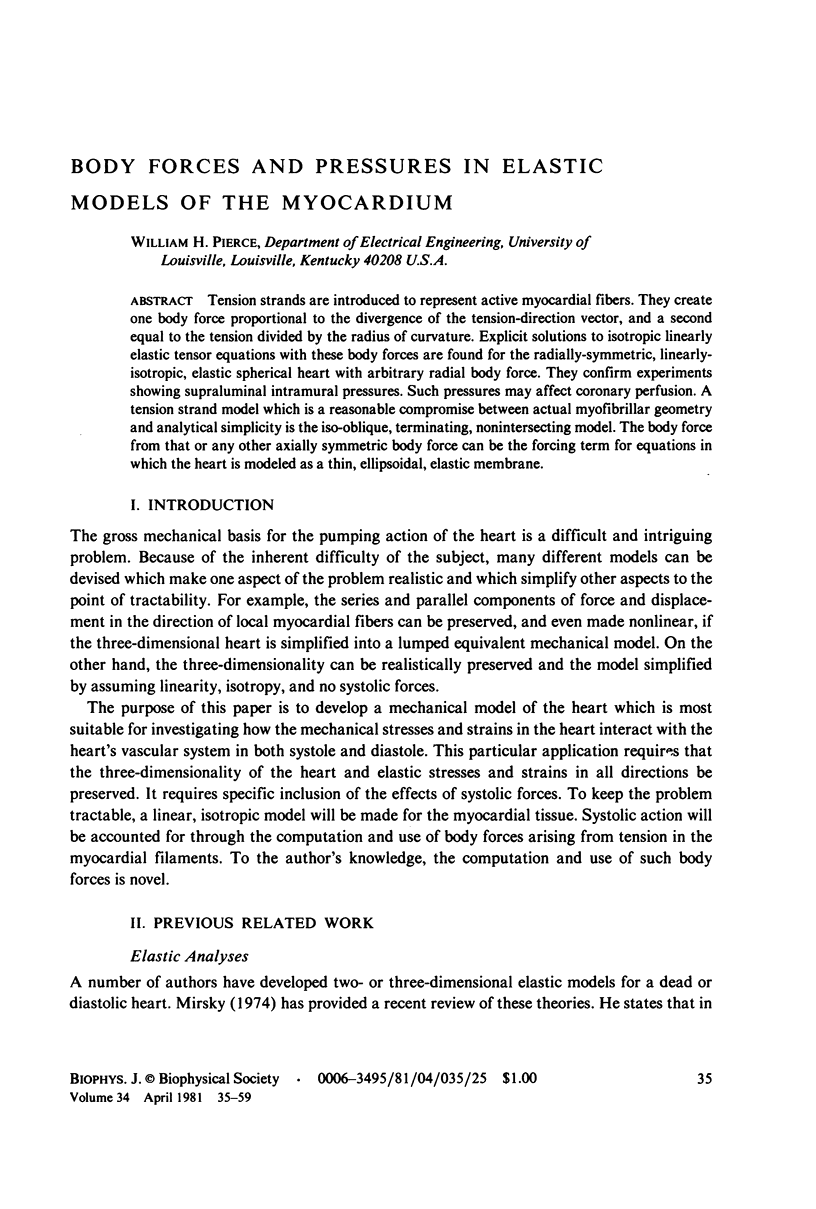
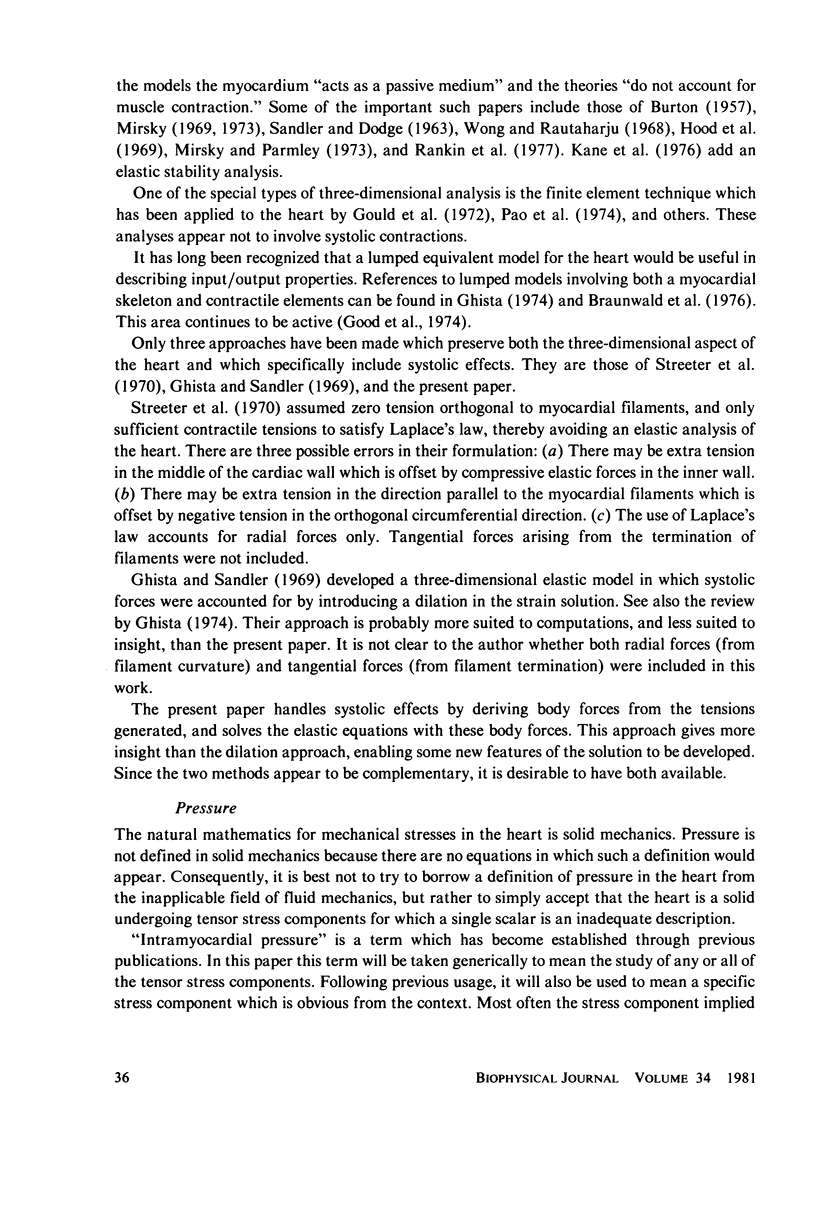
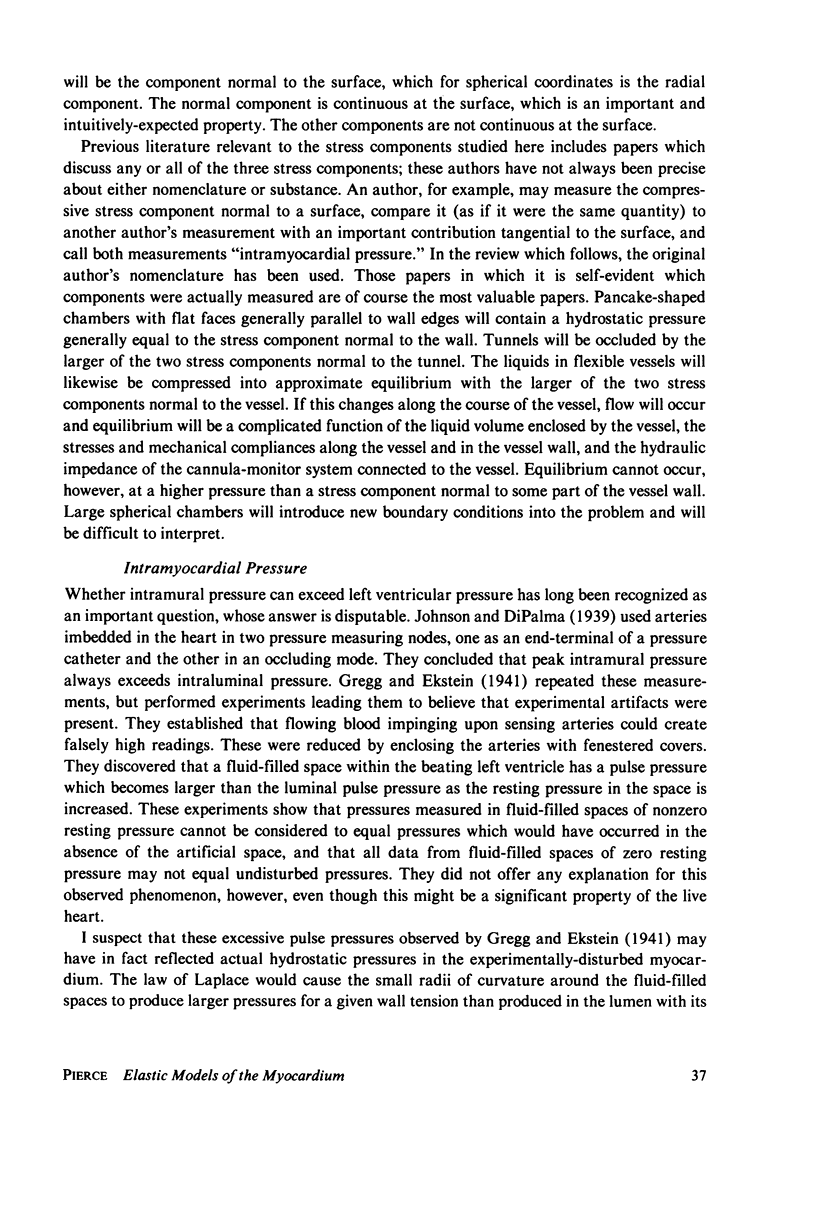
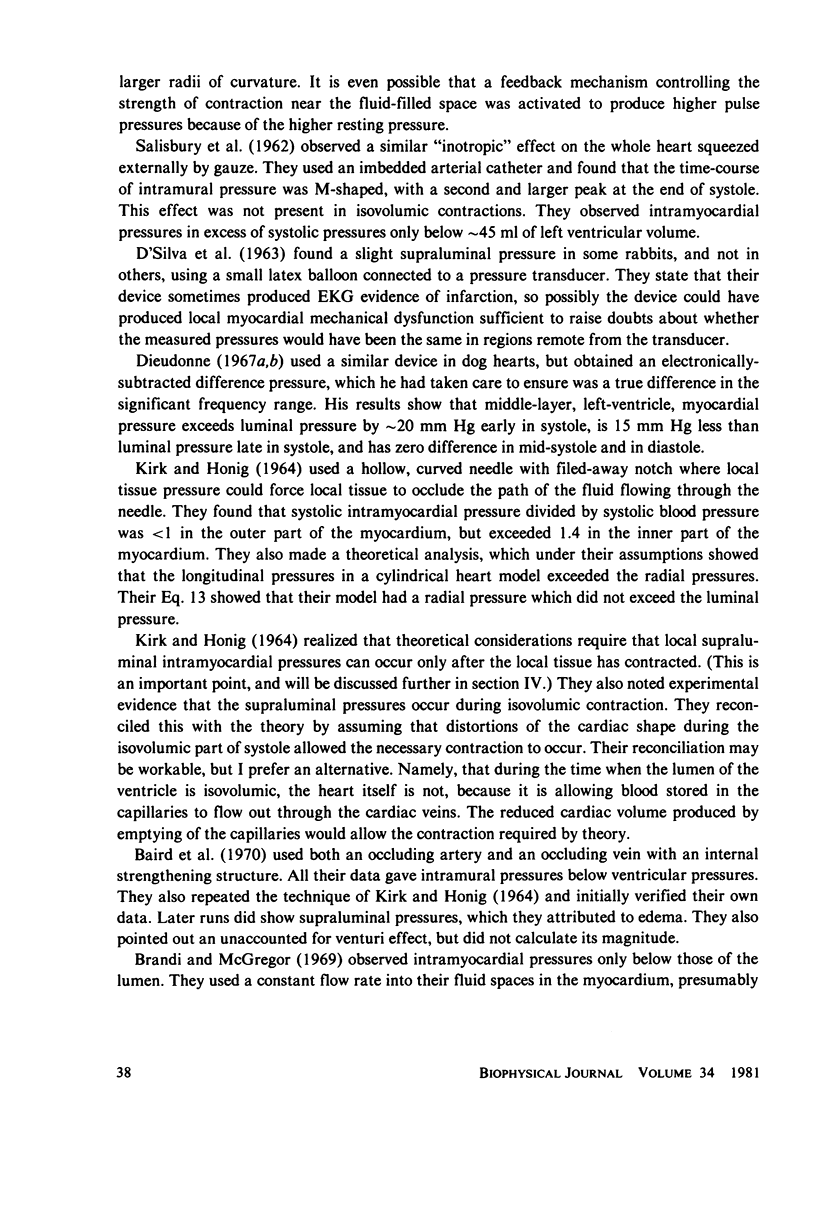
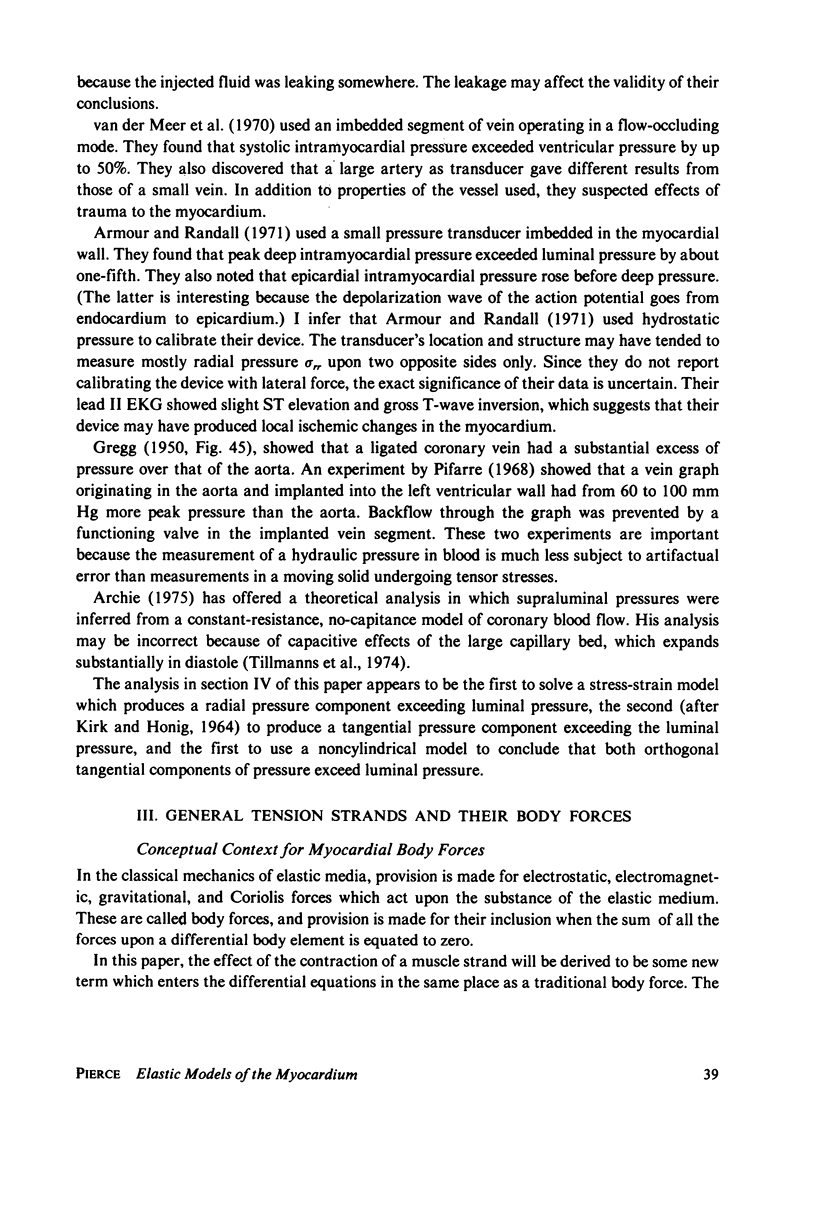
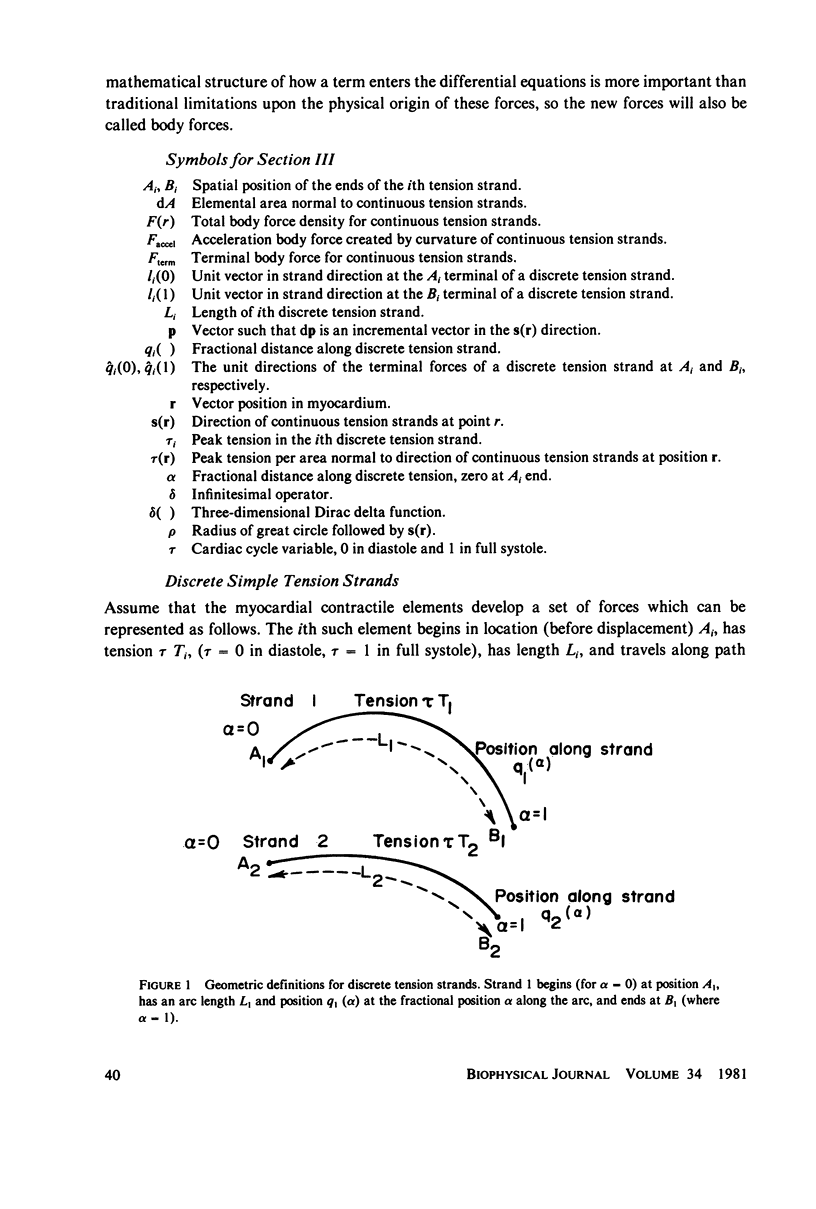
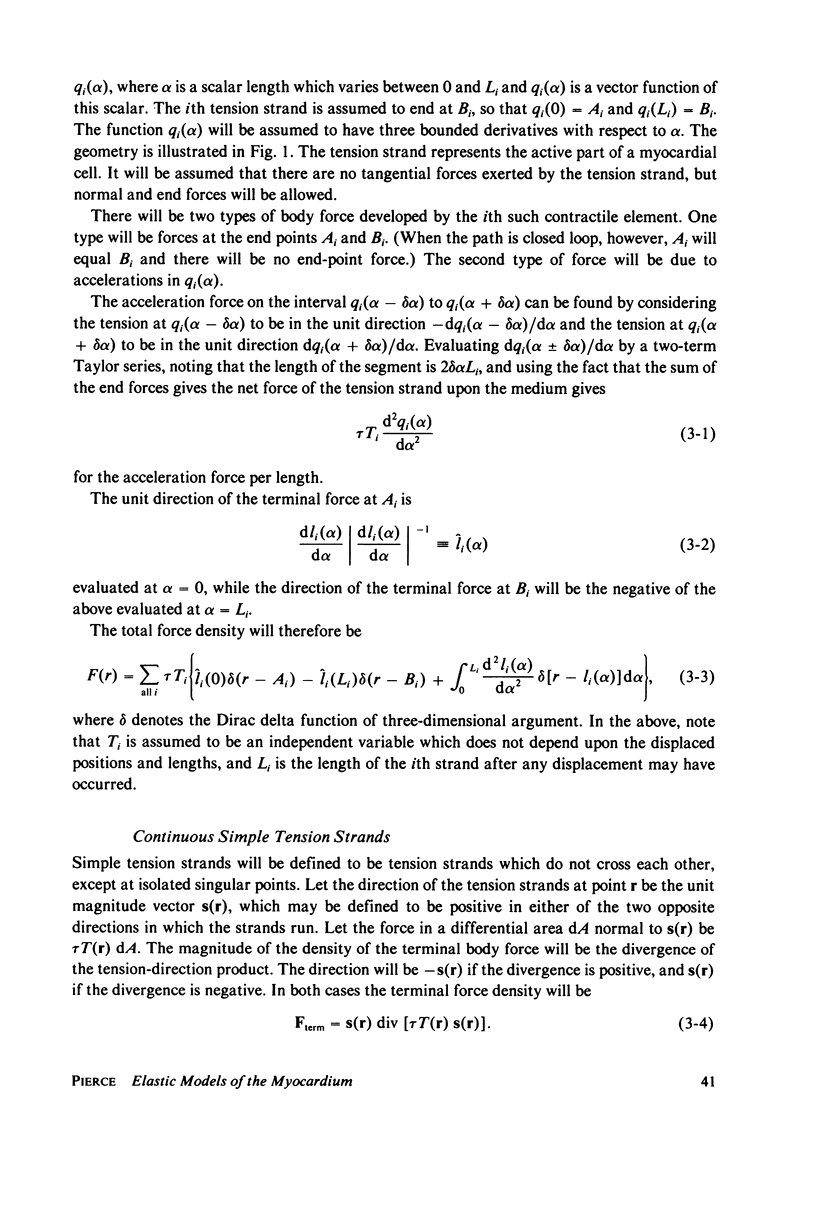
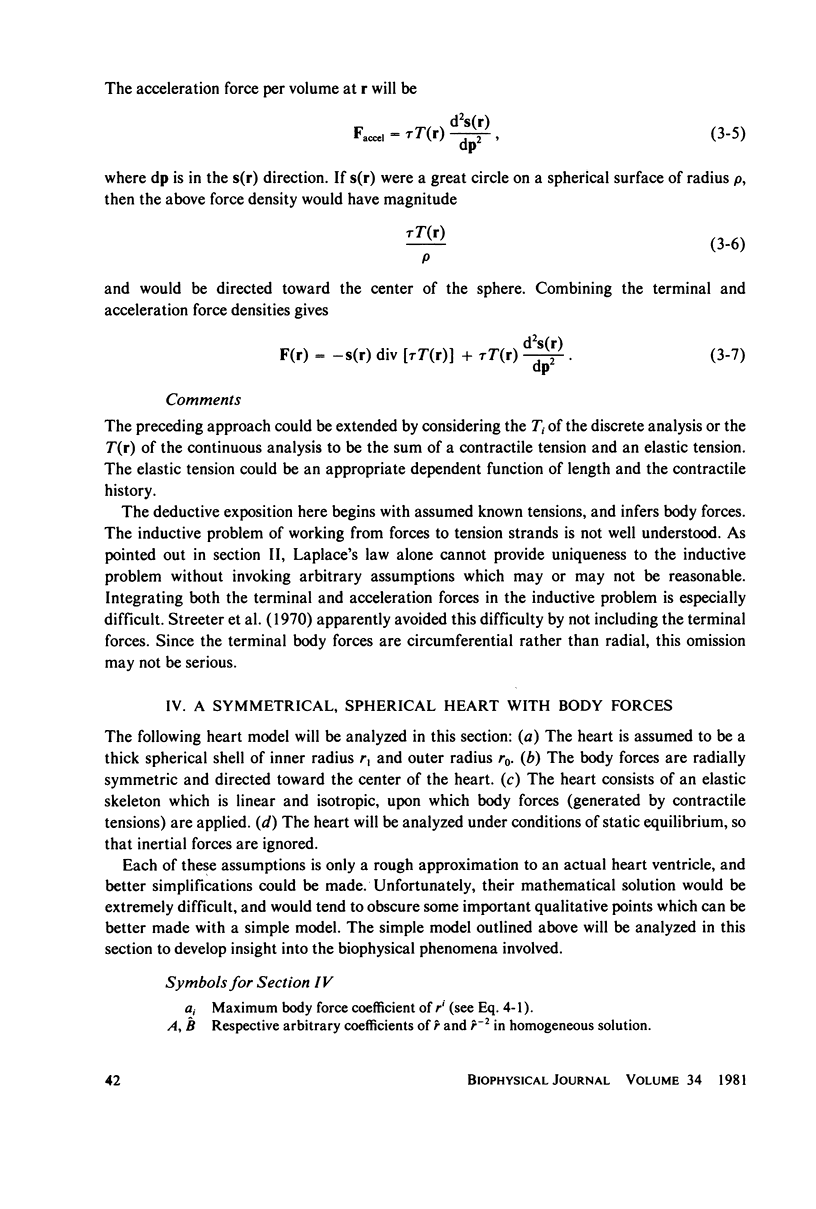
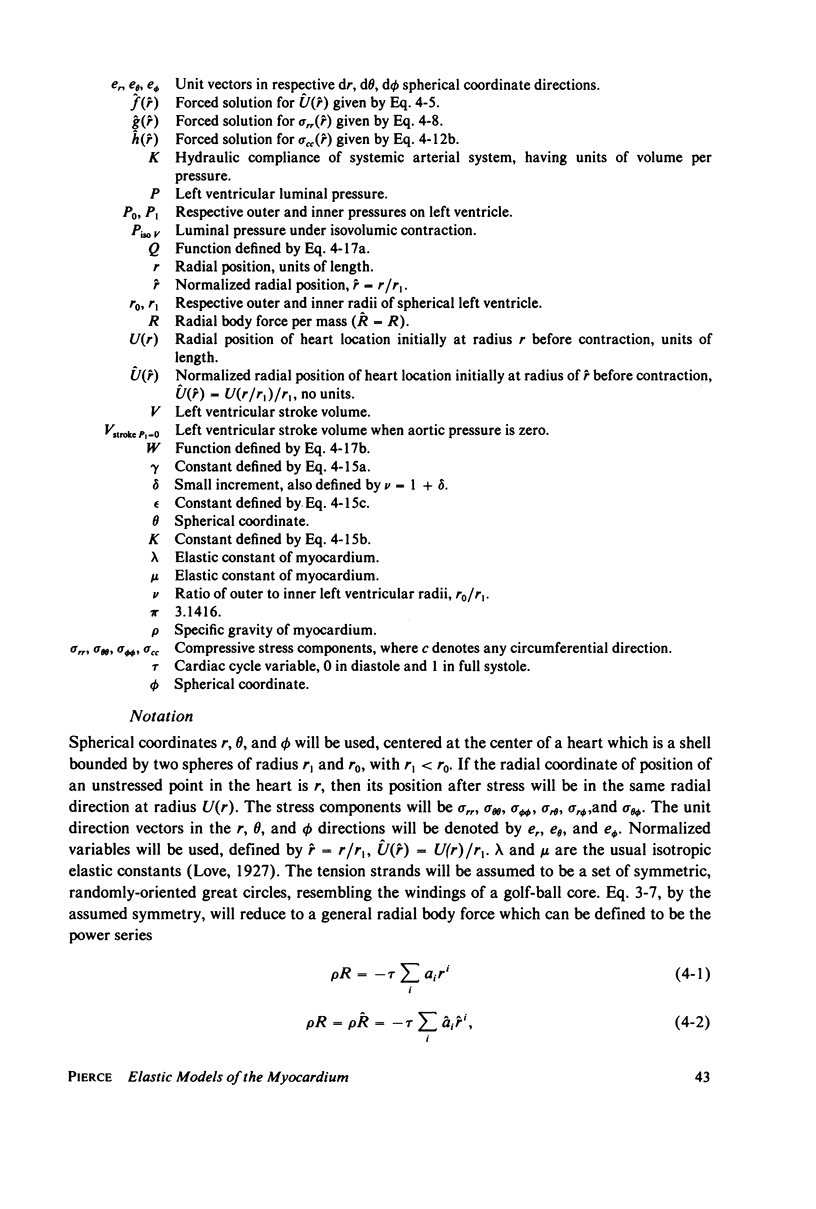
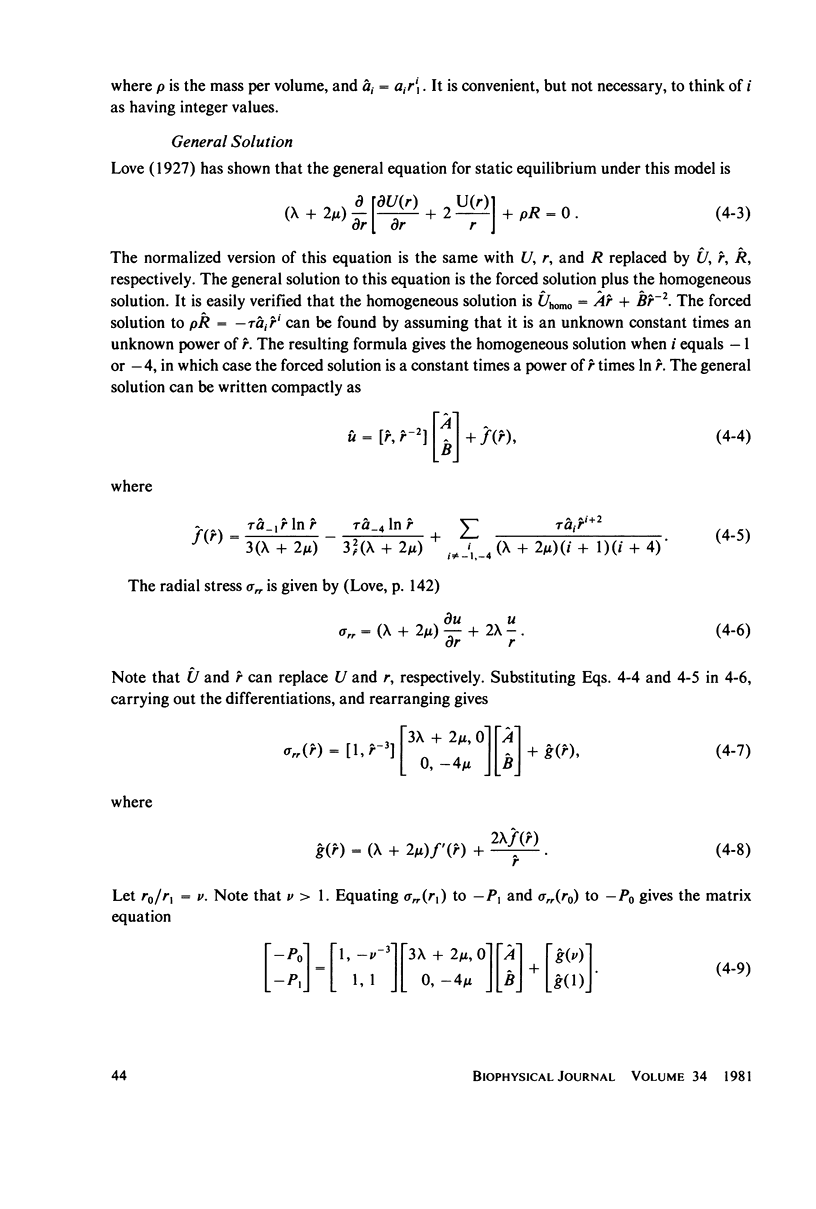
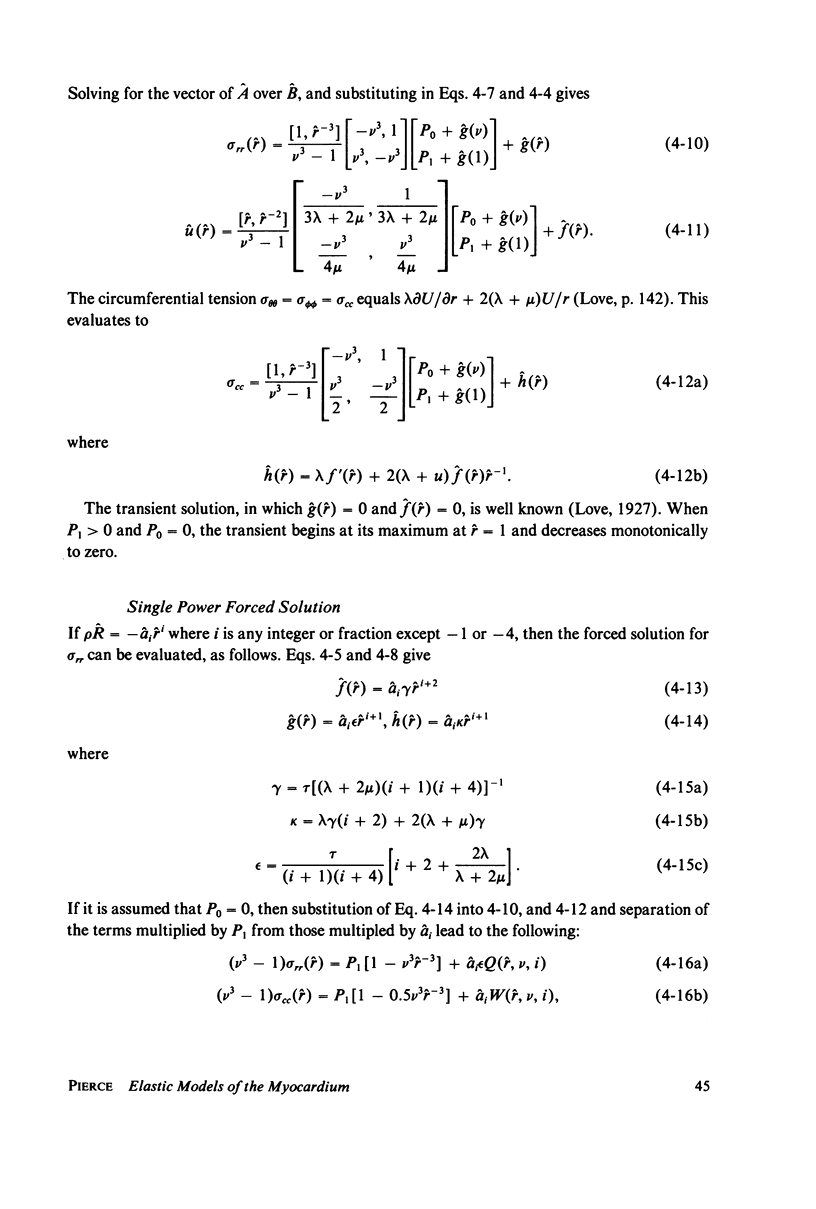
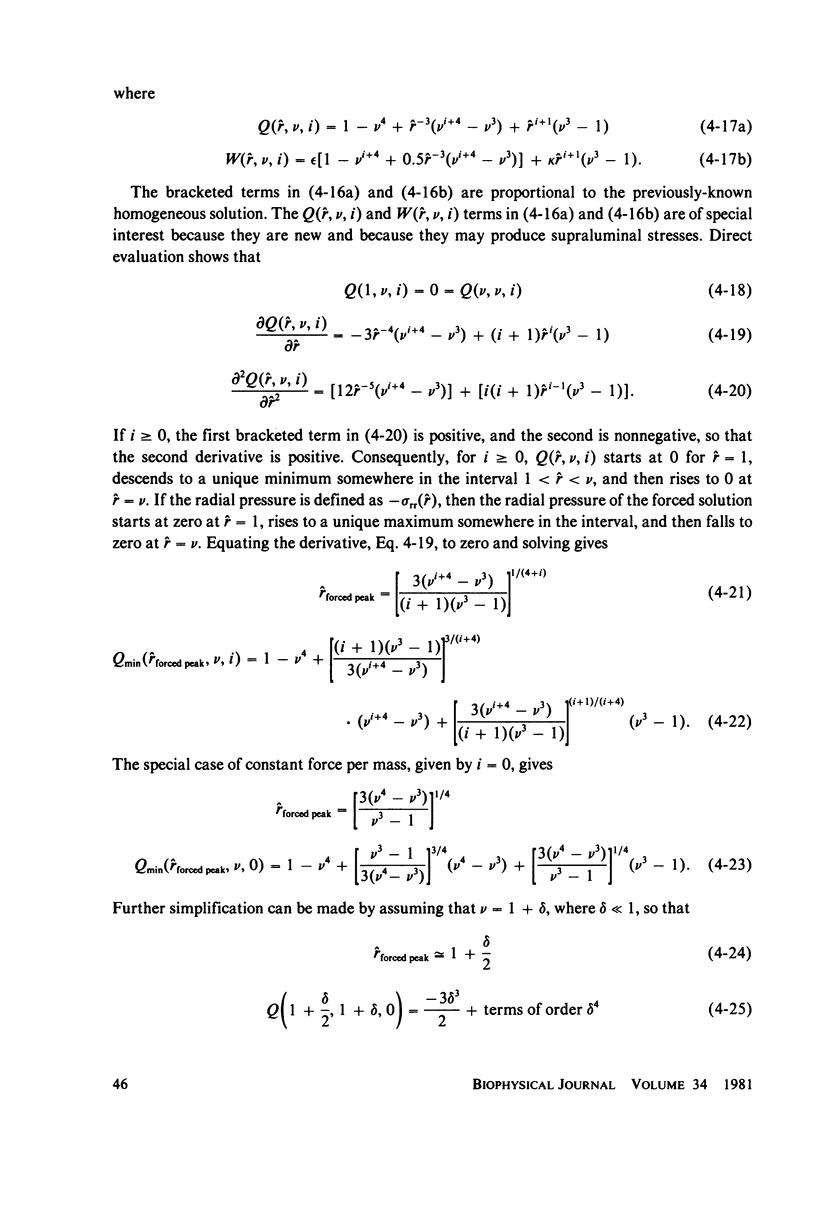
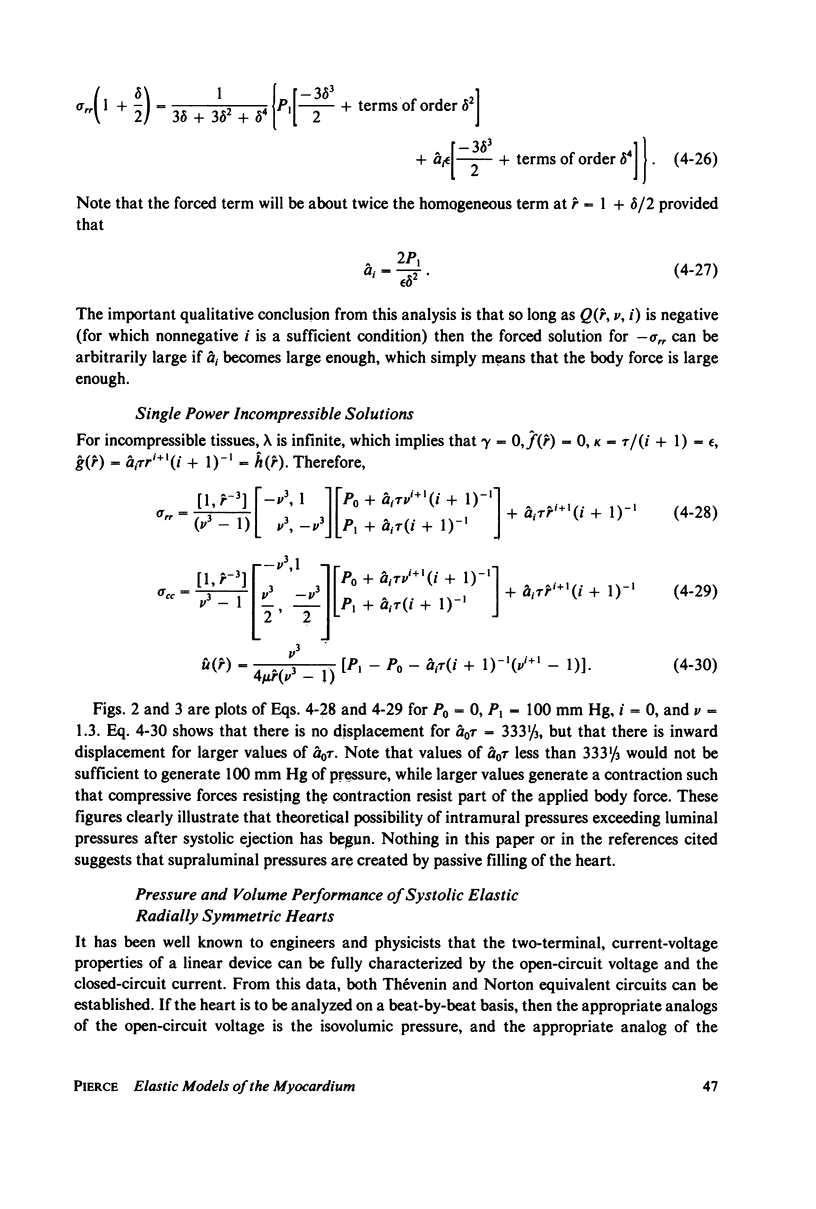
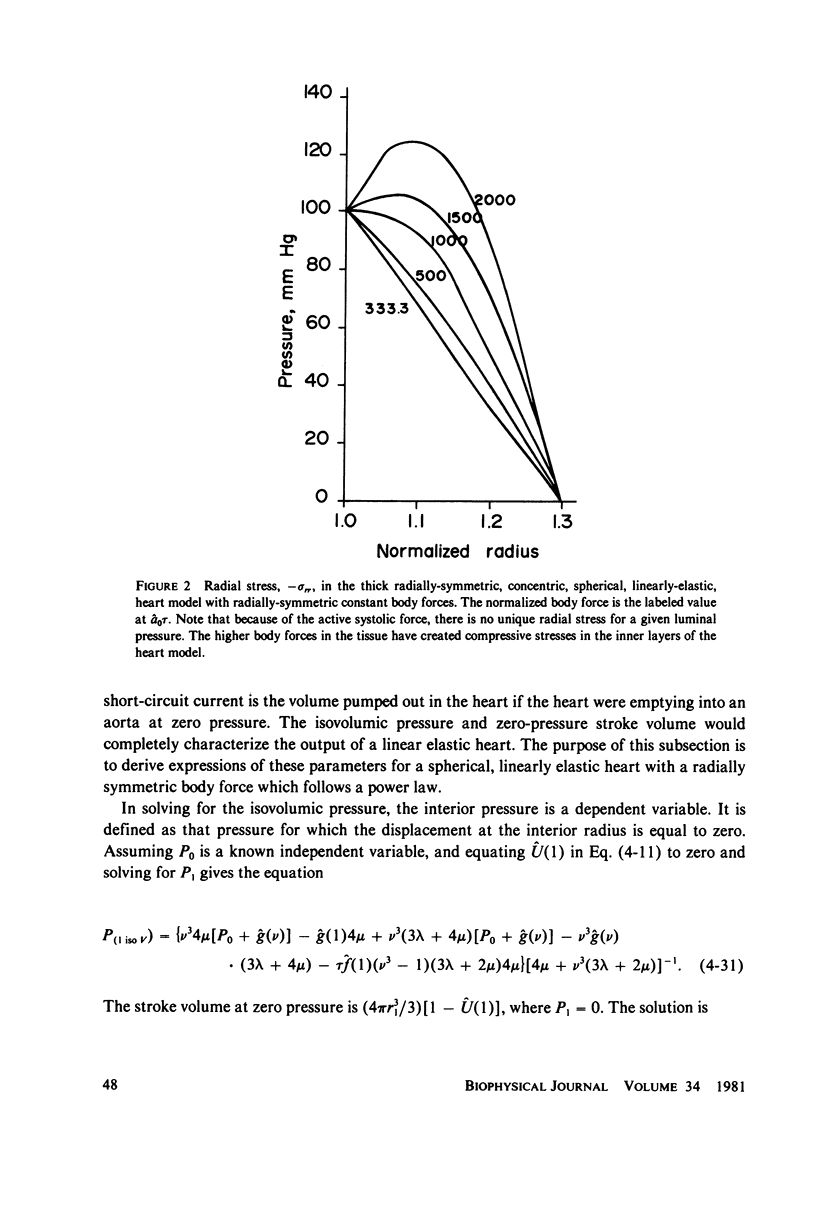
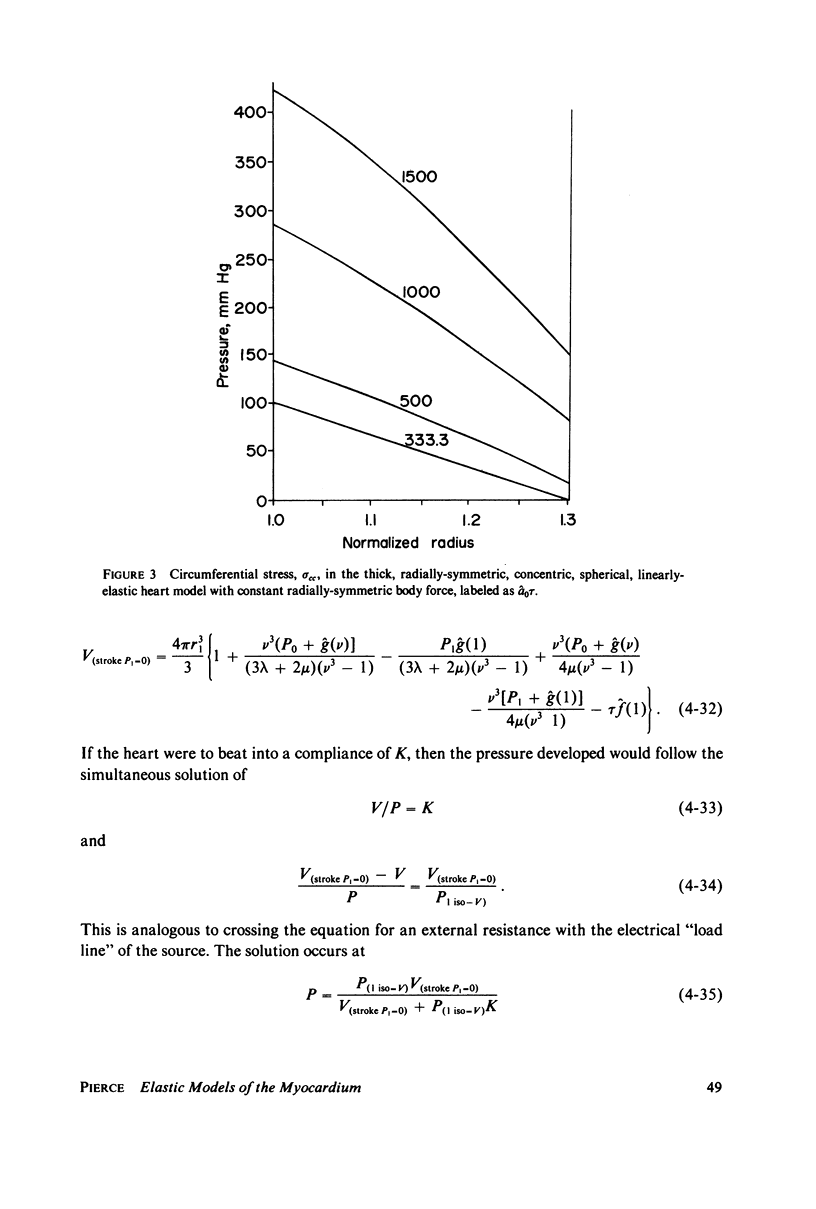
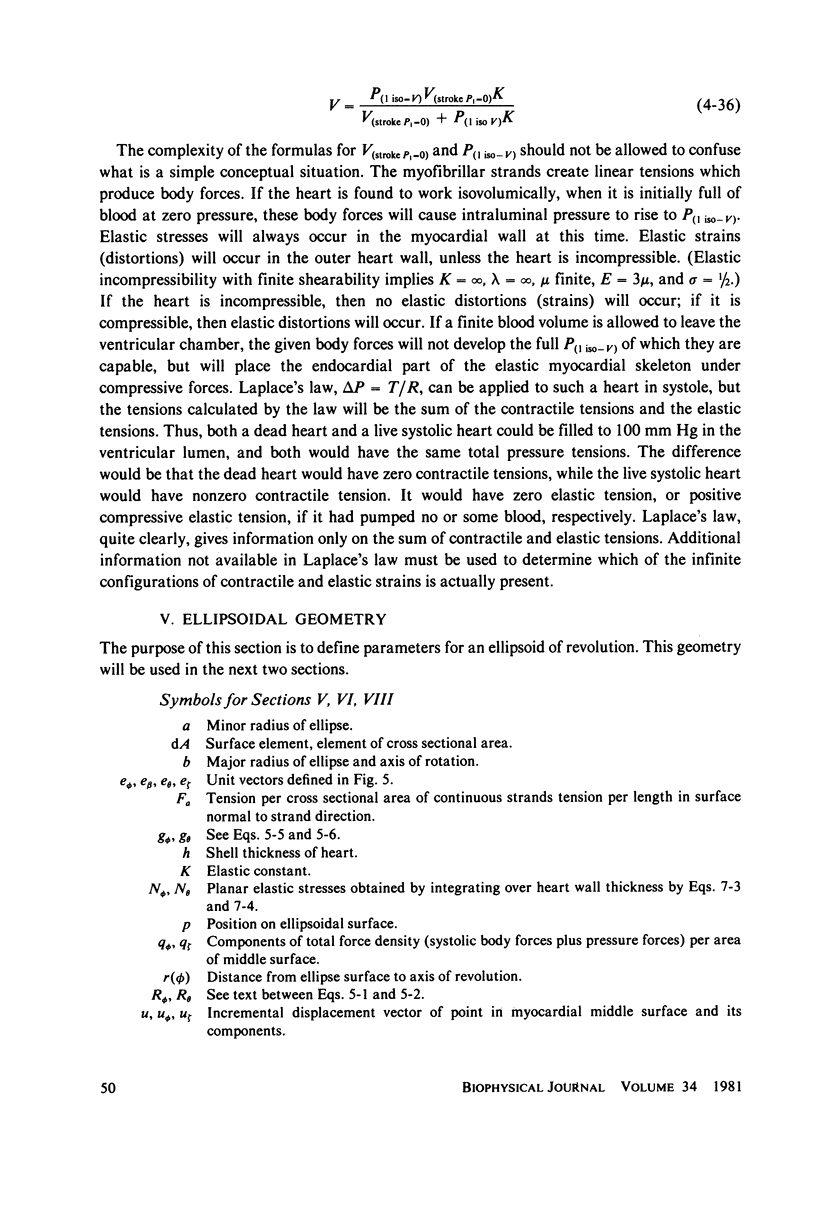
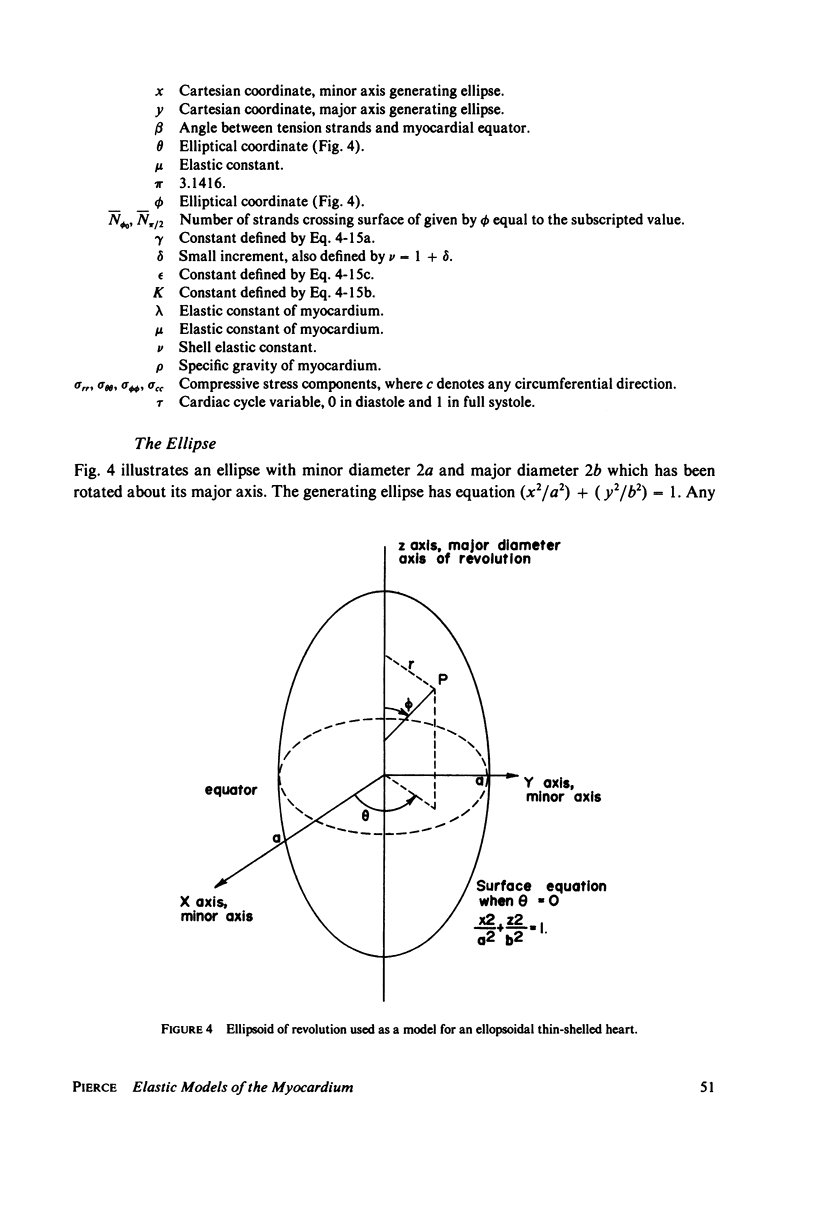
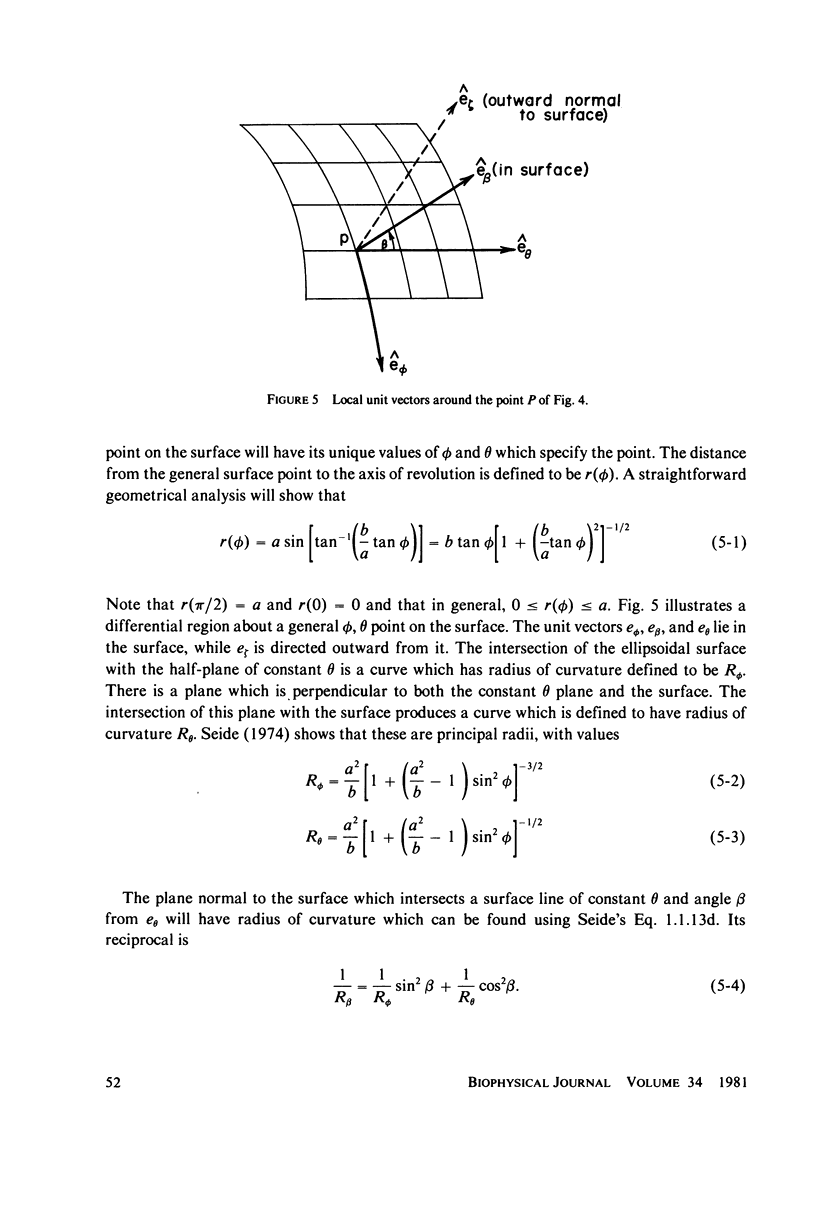
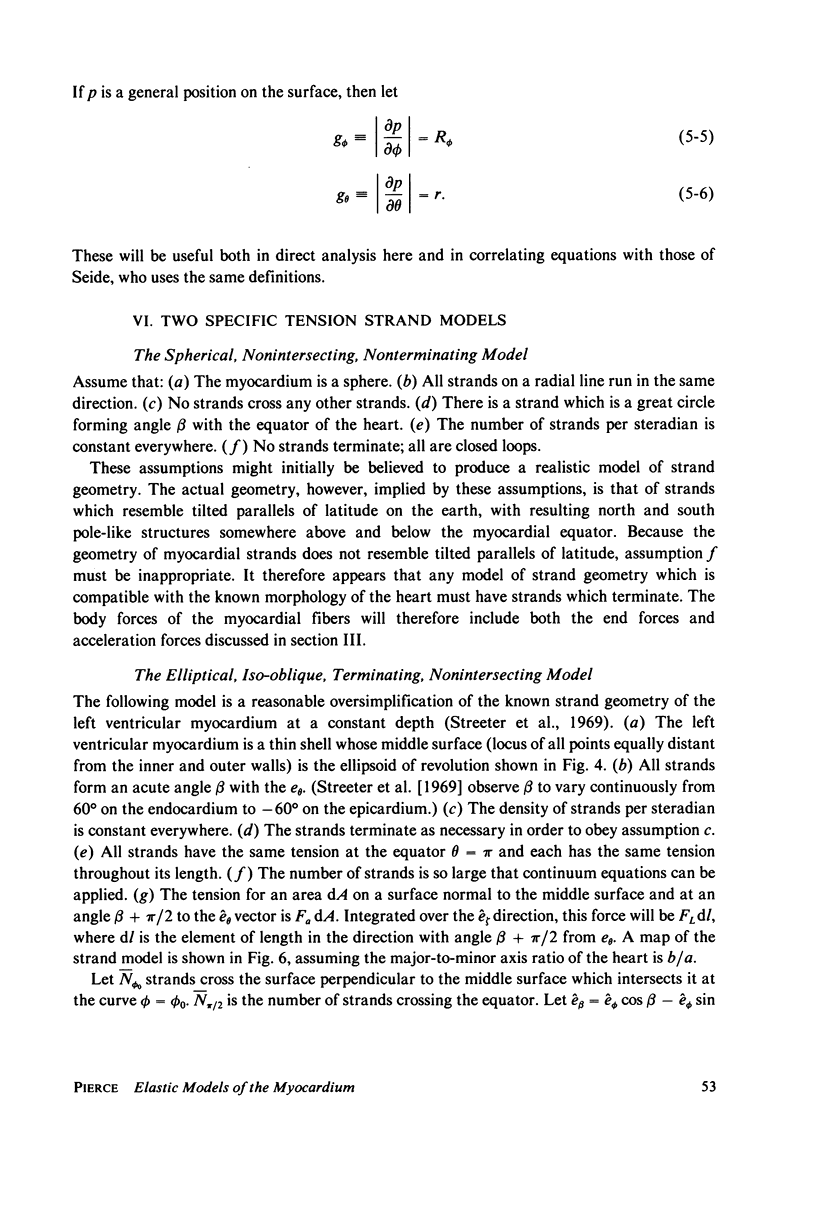
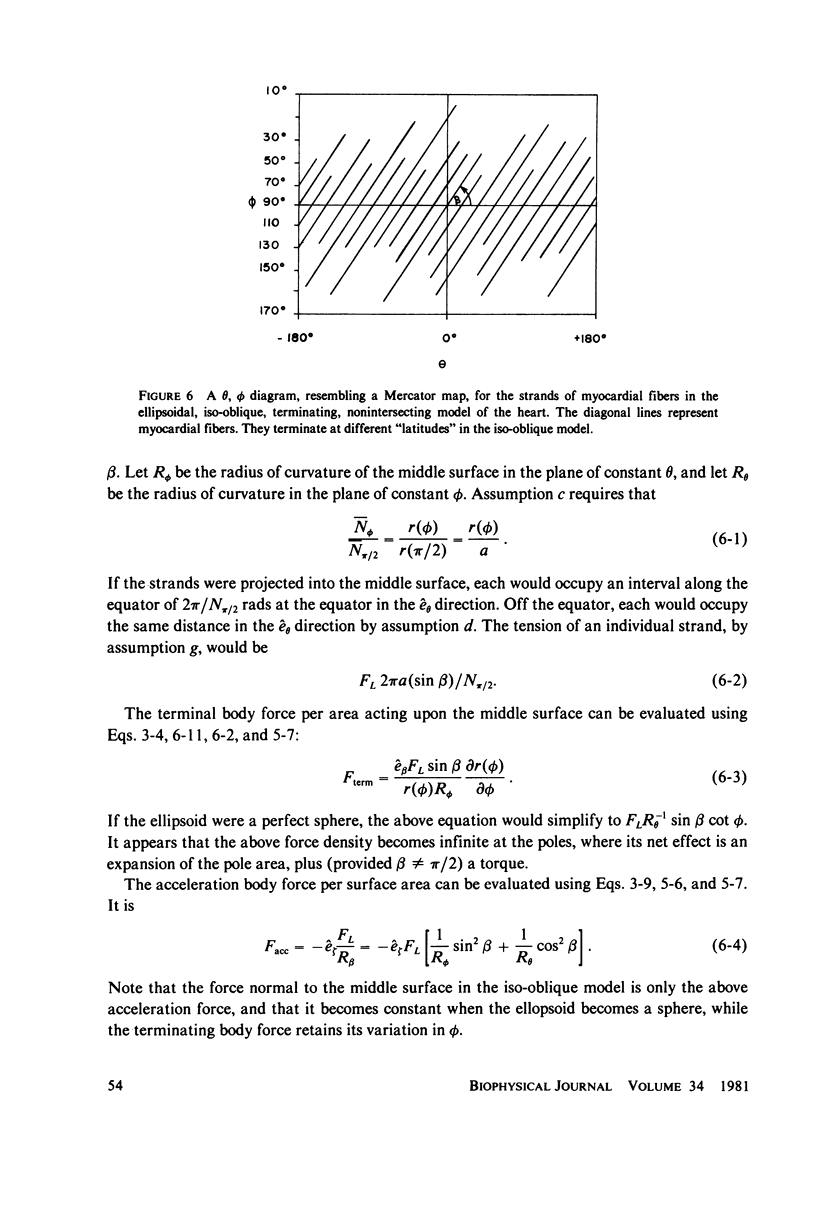
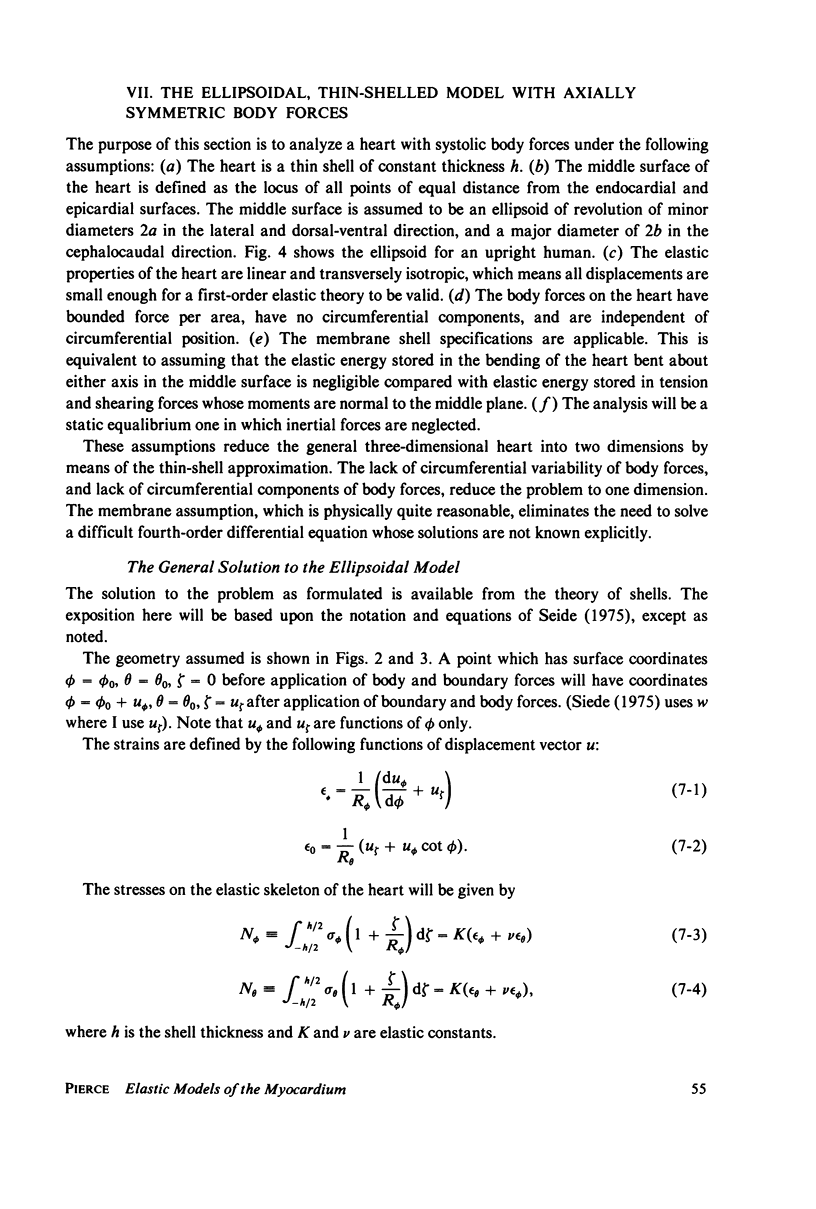
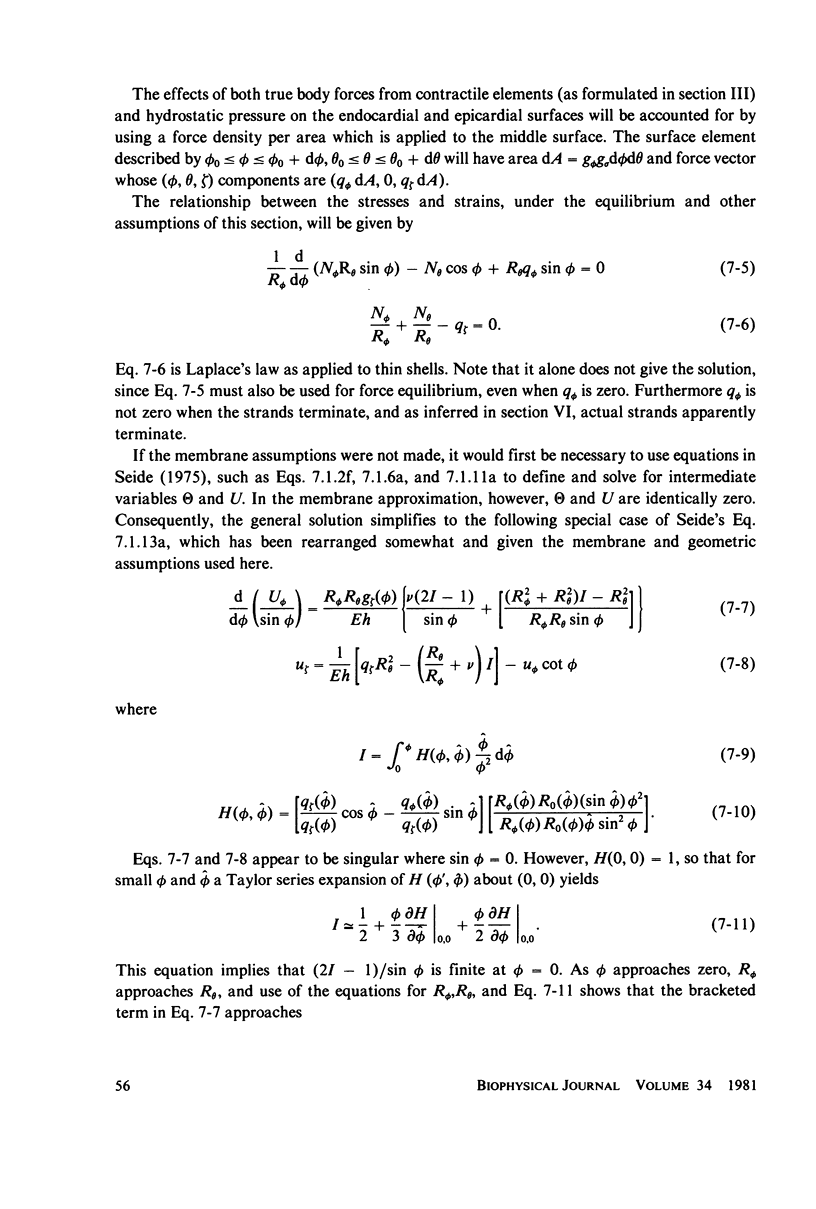
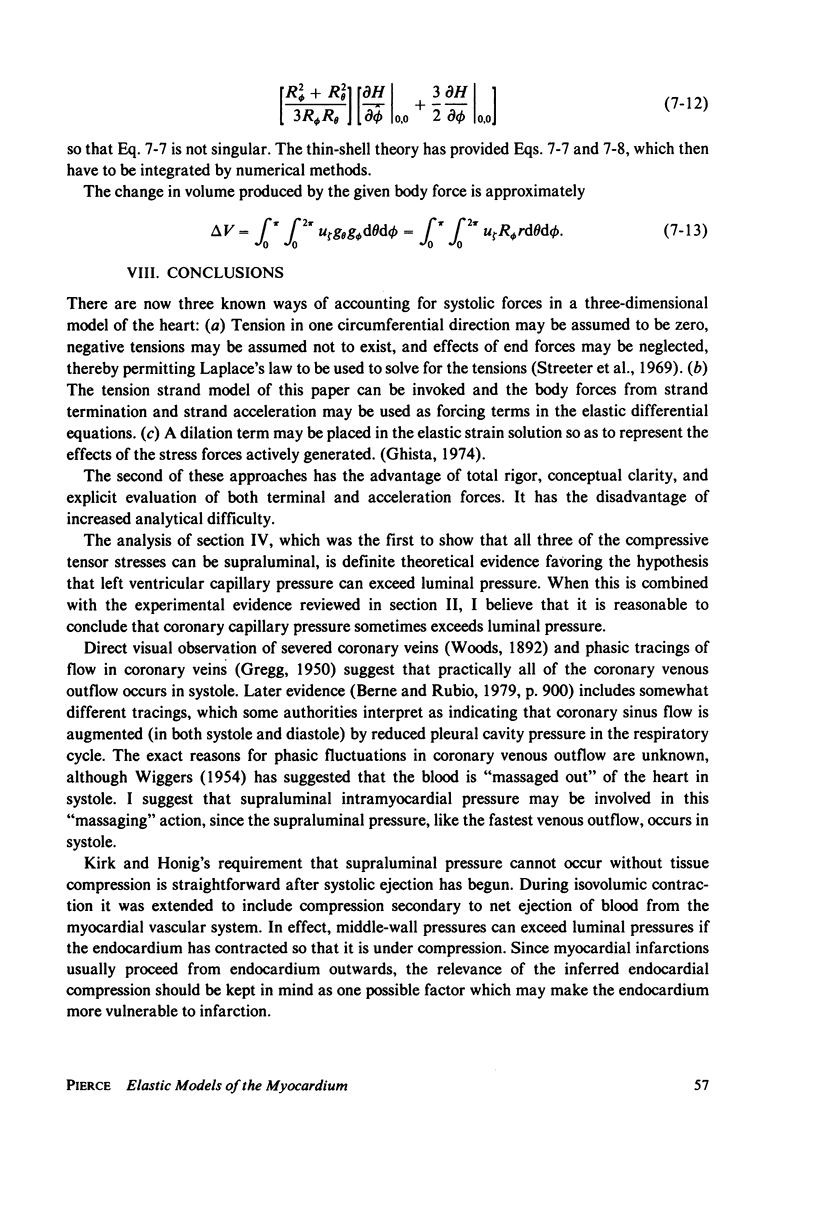
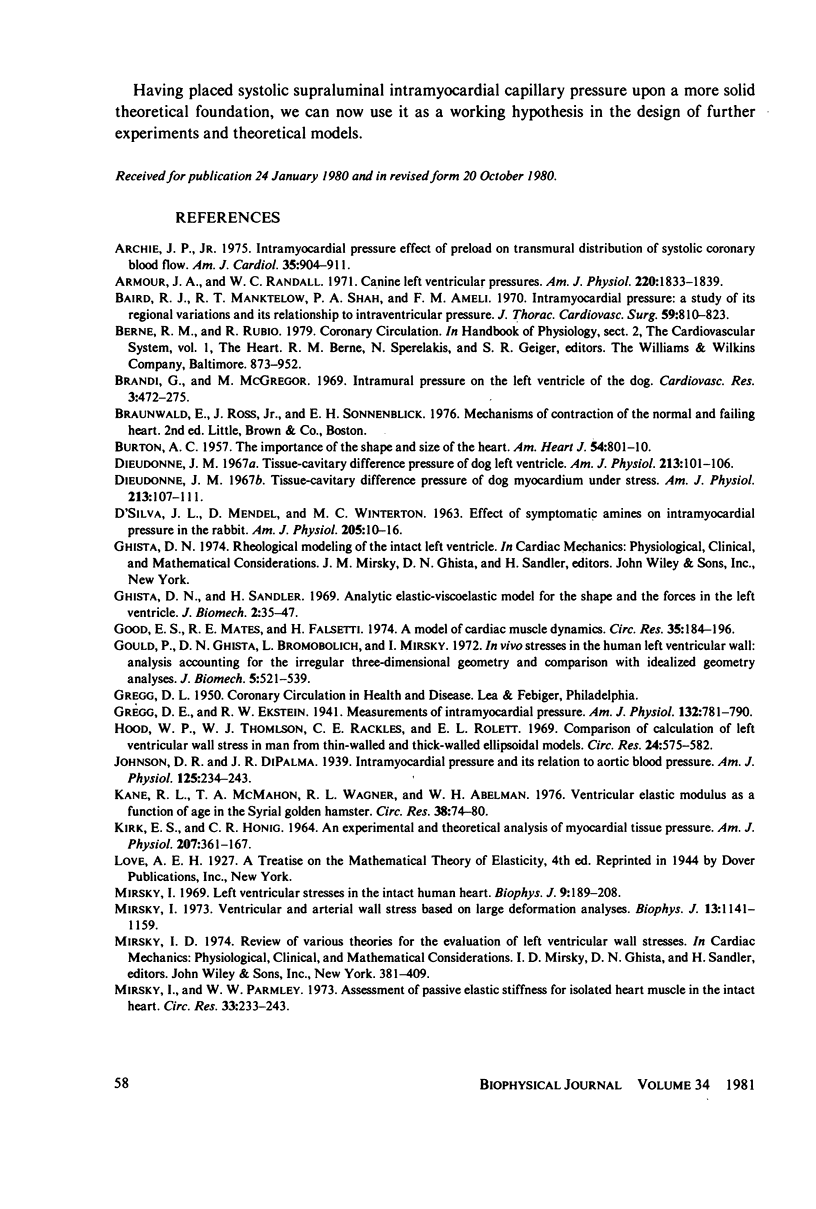
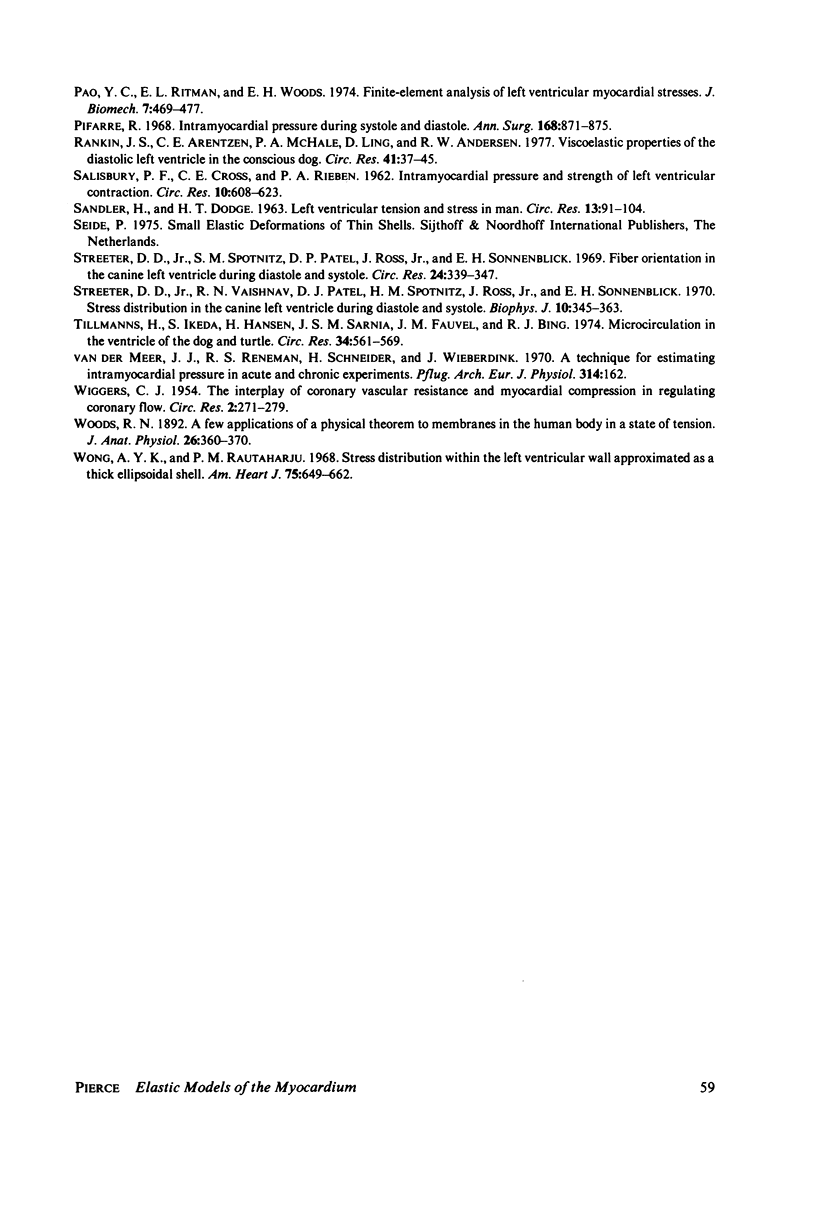
Selected References
These references are in PubMed. This may not be the complete list of references from this article.
- Archie J. P., Jr Intramyocardial pressure: effect of preload on transmural distribution of systolic coronary blood flow. Am J Cardiol. 1975 Jun;35(6):904–911. doi: 10.1016/0002-9149(75)90127-7. [DOI] [PubMed] [Google Scholar]
- Armour J. A., Randall W. C. Canine left ventricular intramyocardial pressures. Am J Physiol. 1971 Jun;220(6):1833–1839. doi: 10.1152/ajplegacy.1971.220.6.1833. [DOI] [PubMed] [Google Scholar]
- BURTON A. C. The importance of the shape and size of the heart. Am Heart J. 1957 Dec;54(6):801–810. doi: 10.1016/0002-8703(57)90186-2. [DOI] [PubMed] [Google Scholar]
- Baird R. J., Manktelow R. T., Shah P. A., Ameli F. M. Intramyocardial pressure. A study of its regional variations and its relationship to intraventricular pressure. J Thorac Cardiovasc Surg. 1970 Jun;59(6):810–823. [PubMed] [Google Scholar]
- Brandi G., McGregor M. Intramural pressure in the left ventricle of the dog. Cardiovasc Res. 1969 Oct;3(4):472–475. doi: 10.1093/cvr/3.4.472. [DOI] [PubMed] [Google Scholar]
- Dieudonné J. M. Tissue-cavitary difference pressure of dog left ventricle. Am J Physiol. 1967 Jul;213(1):101–106. doi: 10.1152/ajplegacy.1967.213.1.101. [DOI] [PubMed] [Google Scholar]
- Dieudonné J. M. Tissue-cavitary difference pressure of dog myocardium under stress. Am J Physiol. 1967 Jul;213(1):107–111. doi: 10.1152/ajplegacy.1967.213.1.107. [DOI] [PubMed] [Google Scholar]
- Ghista D. N., Sandler H. An analytic elastic-viscoelastic model for the shape and the forces in the left ventricle. J Biomech. 1969 Mar;2(1):35–47. doi: 10.1016/0021-9290(69)90040-2. [DOI] [PubMed] [Google Scholar]
- Gould P., Ghista D., Brombolich L., Mirsky I. In vivo stresses in the human left ventricular wall: analysis accounting for the irregular 3-dimensional geometry and comparison with idealised geometry analyses. J Biomech. 1972 Sep;5(5):521–539. doi: 10.1016/0021-9290(72)90009-7. [DOI] [PubMed] [Google Scholar]
- Hood W. P., Jr, Thomson W. J., Rackley C. E., Rolett E. L. Comparison of calculations of left ventricular wall stress in man from thin-walled and thick-walled ellipsoidal models. Circ Res. 1969 Apr;24(4):575–582. doi: 10.1161/01.res.24.4.575. [DOI] [PubMed] [Google Scholar]
- KIRK E. S., HONIG C. R. AN EXPERIMENTAL AND THEORETICAL ANALYSIS OF MYOCARDIAL TISSUE PRESSURE. Am J Physiol. 1964 Aug;207:361–367. doi: 10.1152/ajplegacy.1964.207.2.361. [DOI] [PubMed] [Google Scholar]
- Kane R. L., McMahon T. A., Wagner R. L., Abelmann W. H. Ventricular elastic modulus as a function of age in the Syrian golden hamster. Circ Res. 1976 Feb;38(2):74–80. doi: 10.1161/01.res.38.2.74. [DOI] [PubMed] [Google Scholar]
- Mirsky I. Left ventricular stresses in the intact human heart. Biophys J. 1969 Feb;9(2):189–208. doi: 10.1016/S0006-3495(69)86379-4. [DOI] [PMC free article] [PubMed] [Google Scholar]
- Mirsky I., Parmley W. W. Assessment of passive elastic stiffness for isolated heart muscle and the intact heart. Circ Res. 1973 Aug;33(2):233–243. doi: 10.1161/01.res.33.2.233. [DOI] [PubMed] [Google Scholar]
- Mirsky I. Ventricular and arterial wall stresses based on large deformation analyses. Biophys J. 1973 Nov;13(11):1141–1159. doi: 10.1016/S0006-3495(73)86051-5. [DOI] [PMC free article] [PubMed] [Google Scholar]
- Pao Y. C., Ritman E. L., Wood E. H. Finite-element analysis of left ventricular myocardial stresses. J Biomech. 1974 Nov;7(6):469–477. doi: 10.1016/0021-9290(74)90081-5. [DOI] [PubMed] [Google Scholar]
- Pifarré R. Intramyocardial pressure during systole and diastole. Ann Surg. 1968 Nov;168(5):871–875. doi: 10.1097/00000658-196811000-00013. [DOI] [PMC free article] [PubMed] [Google Scholar]
- Rankin J. S., Arentzen C. E., McHale P. A., Ling D., Anderson R. W. Viscoelastic properties of the diastolic left ventricle in the conscious dog. Circ Res. 1977 Jul;41(1):37–45. doi: 10.1161/01.res.41.1.37. [DOI] [PubMed] [Google Scholar]
- SALISBURY P. F., CROSS C. E., RIEBEN P. A. Intramyocardial pressure and strength of left ventricular contraction. Circ Res. 1962 Apr;10:608–623. doi: 10.1161/01.res.10.4.608. [DOI] [PubMed] [Google Scholar]
- SANDLER H., DODGE H. T. LEFT VENTRICULAR TENSION AND STRESS IN MAN. Circ Res. 1963 Aug;13:91–104. doi: 10.1161/01.res.13.2.91. [DOI] [PubMed] [Google Scholar]
- Streeter D. D., Jr, Spotnitz H. M., Patel D. P., Ross J., Jr, Sonnenblick E. H. Fiber orientation in the canine left ventricle during diastole and systole. Circ Res. 1969 Mar;24(3):339–347. doi: 10.1161/01.res.24.3.339. [DOI] [PubMed] [Google Scholar]
- Streeter D. D., Jr, Vaishnav R. N., Patel D. J., Spotnitz H. M., Ross J., Jr, Sonnenblick E. H. Stress distribution in the canine left ventricle during diastole and systole. Biophys J. 1970 Apr;10(4):345–363. doi: 10.1016/S0006-3495(70)86306-8. [DOI] [PMC free article] [PubMed] [Google Scholar]
- Tillmanns H., Ikeda S., Hansen H., Sarma J. S., Fauvel J. M., Bing R. J. Microcirculation in the ventricle of the dog and turtle. Circ Res. 1974 Apr;34(4):561–569. doi: 10.1161/01.res.34.4.561. [DOI] [PubMed] [Google Scholar]
- WIGGERS C. J. The interplay of coronary vascular resistance and myocardial compression in regulating coronary flow. Circ Res. 1954 May;2(3):271–279. doi: 10.1161/01.res.2.3.271. [DOI] [PubMed] [Google Scholar]
- Wong A. Y., Rautaharju P. M. Stress distribution within the left ventricular wall approximated as a thick ellipsoidal shell. Am Heart J. 1968 May;75(5):649–662. doi: 10.1016/0002-8703(68)90325-6. [DOI] [PubMed] [Google Scholar]
- Woods R H. A Few Applications of a Physical Theorem to Membranes in the Human Body in a State of Tension. J Anat Physiol. 1892 Apr;26(Pt 3):362–370. [PMC free article] [PubMed] [Google Scholar]
- van der Meer J. J., Reneman R. S., Schneider H., Wieberdink J. A technic for estimating intramyocardial pressure in acute and chronic experiments. Pflugers Arch. 1970;314(2):162–162. [PubMed] [Google Scholar]


